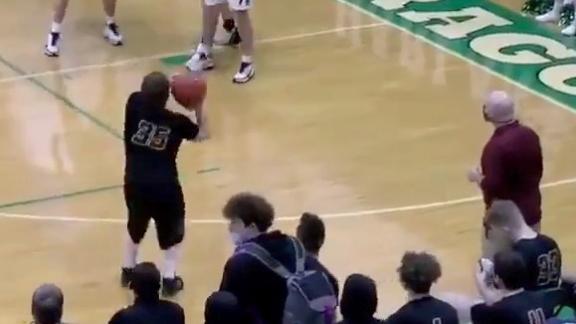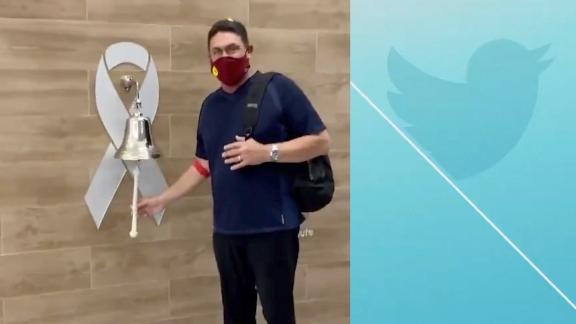With all this newfound time on our hands before the second round kicks off on Friday, let's look at what we learned in the opening round of the NCAA women's soccer tournament.
The new format is neither evil incarnate nor a perfect solution. The old format for the NCAA tournament featured 16 sites for the opening weekend, each hosting four teams playing out two rounds. Generally, although geography and travel costs sometimes intervened, the 16 national seeds had an opportunity to host. The format on display this year reduced the opening weekend to one round played at 32 sites.
The NCAA's stated goal in altering the format was to enhance the experience of the opening round -- to give more student-athletes an opportunity to play NCAA tournament games in front of a home crowd and to give more fans an opportunity to watch their team in the postseason without driving hundreds of miles.
The early results suggest some success toward that goal, but they do little to answer a fundamental question: At what cost to competitive integrity is such an aim achieved?
An announced attendance of 254 for Alabama at Miami notwithstanding, there were good crowds at games between unseeded teams that would have been at neutral sites in seasons past. Oregon State drew 1,503 for its game against Portland, thanks to a surge of traveling Pilots fans. South Carolina and Kentucky each drew more than 1,000 fans for games against Texas and Washington State, respectively.
Wisconsin-Milwaukee drew 757 fans, the fourth-largest crowd in program history and enough to fill a small venue and create a genuinely fun atmosphere against Illinois State.
"I know there were some disagreements from some teams that tend to go further in the tournament every year," Milwaukee coach Michael Moynihan said of the new format. "Some of them weren't happy, they felt that the game schedule as the tournament went on got too congested, and it wasn't in the best interests of soccer at that level. But I really like it. I think it benefits the student-athletes, the whole experience. Being here tonight, it was a fantastic crowd, a lot of students were out at the game."
The flip side is the issue of competitive fairness. Consider the case of No. 3 Texas A&M, which attendance history suggests would have drawn one of the biggest crowds of the tournament for a second-round game at home. Instead, it will play Virginia Tech on a neutral field in Charlottesville, Va., on Friday. Exactly how neutral it is will depend on how many Hokies fans make the drive from Blacksburg, Va., but the Aggies are getting the short end of the stick regardless, playing that game on Friday and, if they win, having to turn around and play No. 2 Virginia on its home field two days later.
Some other thoughts from the opening weekend:
Maybe it isn't the SEC's year
Well, that didn't go so well. After crowding the top of the RPI all season, the SEC landed eight teams in the NCAA tournament and seemed in position to finally make a multifront splash in November. Instead, four of eight teams are out after the first round, most notably No. 4 Tennessee crashing out in a 3-0 loss at home against Ohio State.
To be sure, it wasn't an unmitigated disaster. Georgia earned a 2-0 road win at Kansas. Only Tennessee and LSU were beaten soundly of the four losers, and the Tigers put on an entirely respectable performance at Texas A&M before yielding to a potent offense. Alabama and Kentucky had chances to win in overtime, the Crimson Tide falling at Miami and Kentucky at home against Washington State. And familiar faces Auburn, Florida and South Carolina join Georgia in the second round. But when a conference with the ample resources and scant postseason history of the SEC gets eight bids, it doesn't get the luxury of having the results graded on a curve.
Best duel: Bianca Henninger vs. California
Santa Clara's first penalty taker in its shootout against California didn't have a long walk to the spot. Henninger, the Broncos standout goalkeeper and Hermann candidate, took and converted the first PK and then gave her team the upper hand by saving the next shot from California. But give the Bears credit for boldness. Instead of sticking with starting keeper Emily Kruger for the shootout, they turned to redshirt freshman Kathleen Messinger. When she saved Santa Clara's fifth attempt, Cal claimed a place in the second round and bested the college game's best keeper.
Best individual performance: Kaitlyn Gustaves, Long Beach State
Picking one performance from 32 games is a fool's errand, but it's difficult to imagine anyone was better than Long Beach State's senior keeper. Gustaves made 12 saves to help upset No. 3 Pepperdine 1-0 in overtime. The Waves entered the game 8-0-1 at home this season, with a 21-match unbeaten streak (17-0-4) at Rokus Field overall.
Best team performance: Texas A&M
Oklahoma State and Memphis took top scoring honors, with the Cowgirls routing Arkansas-Pine Bluff 9-1 and the Tigers doing the same to Tennessee-Martin by a 7-0 score, but the honor goes to the Aggies. Facing good opposition, the nation's most prolific offense looked ready to keep things going in the postseason, controlling tempo, outshooting LSU 26-6 (including 9-1 in shots on goal) and earning 11 corner kicks.
Biggest surprise: Ohio State routing Tennessee
Pepperdine's loss was a surprise, but not nearly as big a surprise as the fact that the Waves, No. 10 in the final public RPI, had to play a team ranked No. 31 in the RPI in the first round. The stunner was in Knoxville, where Ohio State finally put up a result in line with its College Cup run last season. There's no way of knowing for sure, but the Buckeyes likely received one of the final at-large bids after a 10-8-2 regular season and seventh-place finish in the Big Ten. They didn't play like it against the Lady Vols, taking a lead in the ninth minute but still controlling the attack enough throughout to double Tennessee's shots, including both more shots and corners in the second half.
Biggest piece of history: Illinois beating Notre Dame
Notre Dame exits the tournament in the first round for the first time since 1993, and the first time ever since the field expanded to 64 teams. It's the first time since 1999 the defending national champion was eliminated in its first game (Florida lost to Hartford in the second round after a bye in the first round). What shouldn't be lost in the history is just how hot the Illini are as they head to Oklahoma State. The Big Ten tournament champions are 11-0-1 in their past 12 games and allowed just six goals in that stretch.
Graham Hays covers women's college soccer and softball for ESPN.com. Email him at Graham.Hays@espn.com. Follow him on Twitter: @grahamhays.
Follow ESPN.com's college sports coverage on Twitter @ESPN_College and on Facebook.




